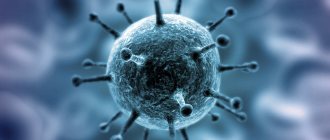There are a number of diseases that humans and domestic cats can infect each other with. One of them is helminthic infestation. Some parasites are common to cats and people; for some, the pet is a “transit point”, a temporary host. Let's consider how you can become infected with worms from a cat, and what measures to take to prevent this from happening.
Ways of infection by parasites
Helminths reproduce by laying eggs. When they come out with the excrement of an infected animal, they can persist for some time outside the host’s body, in the external environment. The cat licks itself, so parasites can end up on its face, fur, and paws. Therefore, the most common way of infecting a person with helminths from a cat is through contact.
By kissing and stroking a cat, a person can pick up parasite eggs if he does not wash his hands.
It is very easy to become infected with worms through the feces of a domestic cat. You should clean the tray as often as possible while wearing rubber gloves. A cat's litter box is the most dangerous place to become infected, since helminth eggs are released in feces.
Also read the article about worms in cats.
Methods for preventing helminthiasis
The simplest advice that will protect the whole family from infection through a pet is that the cat must be healthy. To reduce the risk of infection, the following rules exist:
- Every 3 months the animal should be given antiparasitic tablets, even if there are no signs of worms. Many invasions develop gradually, and at first a person cannot guess about it due to the lack of external signs.
- Raw fish should not be given, especially for river varieties. If the cat loves fish, then it must be boiled first.
- It is necessary to ensure that outdoor shoes are not accessible to the animal, since worm eggs may be on the sole.
- There must be mosquito nets on the windows. During the warm season, large insects can enter an apartment or house through open windows, which the cat will begin to hunt for. Insects are intermediate hosts of many helminths.
In most cases, these simple tips help to avoid major health problems for all household members without exception.
Symptoms of parasitic infestation
To prevent infection with helminths, the owner needs to monitor the health of his pet, regularly take him for examinations to a veterinary clinic, and in between, examine him himself. Absolutely all parasitic organisms do not have the goal of killing their host, because if he dies, they will have nowhere to live. But the constant lack of nutrients, the lion's share of which goes to feed the parasites, as well as the toxins released by them in the process of life, significantly weaken the body of the helminth carrier. And the symptoms of helminthic infestation are always present; a person only needs to carefully monitor the behavior and condition of his pet.
The first sign that a cat has worms is a change in appetite. The cat may refuse to eat or, conversely, constantly ask for food; it may develop unusual cravings. At the same time, the pet becomes lethargic, apathetic, and can lie for days on end, only getting up to go to the bowl.
Also symptoms of helminthic infestation are:
- digestive disorders (alternating constipation and diarrhea or one of these manifestations on an ongoing basis);
- dyspeptic symptoms;
- cough;
- discharge from the eyes;
- the appearance of allergic reactions;
- constant licking of the perineal area due to itching of the anus;
- the presence in the excrement of various impurities (blood, mucus), as well as worms visible to the eye.
If helminths have infected a kitten’s body, it may experience delayed growth and development and slow weight gain. In an adult animal, the condition of the coat deteriorates; in severe cases, convulsions and loss of coordination of movements may occur.
Your pet may complain by meowing loudly if the presence of worms causes pain or discomfort in the abdomen.
When helminths begin to actively grow and multiply, a lump of worms in the intestines causes tension and swelling of the abdomen, and an increase in its size.
If you observe such symptoms, you should immediately contact your veterinarian. He will examine the animal, determine the type of helminthic infestation and prescribe the most effective medications. A sick cat can infect both other pets and people. Therefore, measures should be taken immediately, especially if there are children in the house.
How to avoid getting hookworm?
Hookworm is a nematode (a representative of the order of roundworms) that can parasitize the body of humans and some animals (in particular dogs and cats).
General characteristics of the disease
The helminth - the causative agent of hookworm (shown in the photo) is small in size - the length of the male hookworm does not exceed 11.2 mm, and the female - 18 mm. “The morphological features of hookworm are as follows: at the head end of the worm there is a funnel-shaped oral capsule.” It is surrounded by four sharp teeth - it is with the help of them that the worm attaches to the intestinal tracts. The rear end of the helminth's body is shaped like a bell, consisting of two large and one small blades.
The eggs of the parasite are oval in shape, their shell is completely transparent. The “final point” of the worm’s migration is the small intestine of the host (dogs, cats, humans). In this organ, the parasite, with the help of special teeth, is fixed on the mucous membrane and begins to feed on the host’s blood.
It is also here that the sexually mature hookworm lays eggs, which subsequently enter the external environment along with feces. Here, under favorable climatic conditions, “infectious” larvae - filariae - are formed from eggs. It is at this stage of its development that hookworm becomes invasive for humans and animals (dogs, cats).
Helminth larvae enter the host's body through the skin (in this case, along with the bloodstream, they are spread throughout the body, ending up in the bronchi, lungs, and organs of the digestive tract). Another route of infection is oral: worms end up in the intestines of humans (dogs, cats) along with soil particles, untreated water or unwashed fruits and vegetables.
Another way for parasite larvae to enter the host’s body is intrauterine (transplacental): thus, helminths located in the mother’s soft tissues can become active and penetrate her uterus, from which direct infection of the fetus occurs. Also, worm larvae can end up in the baby’s body along with mother’s milk.
What pathogenic effect does hookworm have on the host (humans, dogs, cats)? The main harm this parasite causes is as follows:
- the migration path of the helminth through the body of humans, cats or dogs is accompanied by significant mechanical trauma to soft tissues;
- the parasitic activity of worms, which are fixed on the intestinal walls, leads to the appearance of erosions and ulcers on the mucous membrane of this organ;
- hookworm provokes pronounced symptoms of intoxication in the owner - this is the body’s immune reaction to the waste products of the nematode;
- worms secrete a secretion into the blood of humans, dogs and cats that prevents normal blood clotting.
It is obvious that the parasitic activity of nematodes in the host body is accompanied by a characteristic clinical picture. Read on to find out what the main symptoms of hookworm infection are.
Signs of helminthiasis
The most typical symptoms of the disease include the following:
- nausea, vomiting, diarrhea, diarrhea and other gastrointestinal disorders;
- anemia;
- geophagy (a person has a desire to eat earth).
Chronic hookworm infection is accompanied by the following symptoms:
- general weakness, headaches and frequent dizziness;
- pain in the epigastrium;
- sudden weight loss;
- swelling of the limbs.
In severe cases with a long course of the disease, large (about 2 cm) ulcers are found on the intestinal walls during diagnosis, which, moreover, bleed intensely. Against the background of such serious blood loss, a patient with chronic hookworm develops symptoms of such a severe pathology as hypochromic iron deficiency anemia. The level of protein in the patient's blood is low - this phenomenon is called hypoalbunemia.
If hookworm infection occurs through the skin, erythema with characteristic red papules appears on the epidermis of the nematode host. In areas with rashes, a feeling of severe itching occurs from time to time.
The parasitic activity of worms in the intestines of the host provokes lethargy, weakness, and increased irritability of a person.
Based on one or another symptom complex of hookworm infection, experts distinguish the following clinical forms of helminthiasis:
- acute gastrointestinal type of illness - it is accompanied by such manifestations as anemia, edema, disorders of the gastrointestinal tract;
- chronic gastrointestinal hookworm - the symptoms are the same, but the course of the disease is slower;
- cachectic form of helminthiasis – there are no dysfunctions of the gastrointestinal tract, but the patient is diagnosed with such manifestations as exhaustion, severe anemia;
- unexpressed type of hookworm - dizziness, rapid heartbeat, headaches;
- atypical form of the disease - skin rashes, cough with a lot of sputum.
In cats, the mucous membranes (in particular, the gums) turn pale. The animal becomes apathetic and inactive. Cat feces take on a black tint. The animal's fur first becomes dull, and then falls out. If there is no antiparasitic treatment for the disease, the cat may even die.
How to identify the disease
The main diagnostic method is the detection of hookworm eggs in the feces of dogs, cats or humans.
A laboratory blood test demonstrates an increased level of eosinophils, and symptoms of hypochromic anemia are detected.
Therapy for helminthiasis
Treatment of the disease is carried out:
- Piperazine;
- Kombantrin;
- Naftamon;
- Levamisole and other anthelmintic drugs.
Antihelminthic treatment in most cases is accompanied by the following unpleasant symptoms:
- vomiting, nausea;
- intoxication syndrome;
- diarrhea;
- painful sensations appear in the patient’s abdomen from time to time;
- allergic reactions;
- changes in blood composition;
- disorders of the nervous system.
Antiparasitic therapy for hookworm infection is best carried out in a hospital setting under the supervision of a specialist.
A month after the antihelminthic treatment is completed and the symptoms of helminthiasis have disappeared, the patient undergoes a control scatological examination of the intestines. Further, such an examination is carried out every year for 4 years.
How to prevent infection
Prevention of hookworm infection is as follows:
- regular sanitary and educational work with the population;
- environmental protection measures aimed at combating soil contamination by feces;
- timely treatment of already infected patients (humans, dogs, cats);
- compliance with basic rules of personal hygiene;
- In epidemiological foci of hookworm (tropical countries), it is prohibited to walk barefoot on the ground.
Hookworms are small nematodes that parasitize the body of humans and some animals (in particular cats and dogs). The activity of helminths in the host’s body is accompanied by gastrointestinal disorders, skin rashes, anemia and signs of intoxication. Antiparasitic therapy with Piperazine, Pyrantel, Dekaris and other pharmaceutical drugs helps to cope with hookworm. With timely treatment of helminthiasis, patients recover completely.
Since the appearance of man on earth, worms have been constantly present in his body. Moreover, they did not penetrate him in order to lead to death. Humans are a source of food for worms. However, there are cases where some patients died due to their activities.
To understand what worms look like in feces, just look at the photo; there are plenty of them online. From them, a person can easily see at what point they should worry. However, this is not a problem, since it is easy to distinguish these creatures in your feces. Many people believe that there are no such parasites inside them. They hold this opinion because it is difficult for them to come to terms with the idea: the body is a habitat for helminths.
Moreover, these creatures can penetrate the human body regardless of age. Young children are especially at risk. They continually try to put objects that contain dangerous dirt and dust into their mouths.
As for adults, helminths can enter their body as a result of eating poorly washed vegetables, fruits and berries, as well as undercooked meat. A dangerous situation can also arise when the same knife or cutting board that has been in contact with raw meat is used to cut different foods.
You will be surprised how many parasites will come out if you drink a glass of regular...
Parasites will leave the body in 3 days! You just need to drink on an empty stomach...
What do worms look like in feces?
In the vast majority of cases, pinworms and roundworms can be detected when a person relieves natural needs in the toilet. Pinworms look like small white worms, no more than 1 cm long. They are present alive in feces. Moreover, even before excrement is released, you can become aware of their presence. The presence of worm eggs and worms in feces is not the only sign of pinworms.
A clue to this may be not only the photo, but also an unpleasant burning sensation in the anus, which often worsens during sleep. In some cases, pinworms can come out on their own, so a person can often find them on the skin or underwear.
Roundworms appear as white, medium-length worms that are found dead or severely weakened in feces. Until such worms appear in the feces, a person does not feel specific symptoms.
To recognize the fact of their presence, you can conduct a special analysis - a coprogram. For this reason, if a person suddenly finds such creatures in his feces, he should not immediately flush the infected feces down the toilet. It is advisable to take some of them and place them in a suitable container so that a specialist can examine them.
Worms in a child's stool
Most often, many pinworms and roundworms are found in children. And the reason for this is simple - babies are accustomed to putting objects into their mouths without worrying about their cleanliness. They also like to feast on unwashed fruits from trees. They pay little attention to maintaining personal hygiene. For this reason, parents should take care of their children, noticing any changes in well-being and constantly monitoring the condition of their feces.
If, after a child’s next trip to the toilet, white pinworms and roundworms are found in the feces, an adult should remove them and try to take them to a medical facility as quickly as possible so that they can be analyzed and be able to choose the appropriate treatment for the baby.
It is worth saying that coprogram is not the only method by which pinworms and roundworms can be detected in the body. Another common technique is a blood test. Sometimes a comprehensive examination may be required.
According to doctors, even with these measures, an accurate result is not always guaranteed. And this is due to the following reasons:
- feces should be submitted for examination immediately after defecation;
- One study is not enough; a repeat study of the stool will be required.
As a result, the doctor decides to carry out therapy based on the fact that white worms or their remains were found in the stool. Obvious symptoms, which include unpleasant itching in the anus, can also prompt him to do this.
Treatment
Currently, medicine has made great progress in treating this problem. Today, many medicines have been created that effectively fight all types of pinworms and roundworms. At the same time, folk remedies are also used for treatment. However, better results can be achieved if natural medicines complement medications and procedures.
It is important to take appropriate measures here. Inaction will only make the situation worse. Do not forget that among helminths there are types of pinworms and roundworms that are dangerous to health. These include the pork tapeworm, whose activity will cause the most unpleasant event - the death of the patient. Moreover, in such situations, a characteristic sign, which is the larvae of worms in the feces, may be absent.
Therapy comes down to an operation to remove such a parasite from the body. It poses a threat to humans due to the fact that in the process of its activities it releases dangerous poisons and toxins into the body.
You need to be careful about the substances that are visible in the stool:
- blood;
- slime;
- worms.
These signs are sufficient reason to submit feces for biological analysis by doctors.
It should be mentioned that among roundworms there are species that feed on human blood. One of them is the whipworm. Its life cycle in the colon is several years. As a result, it absorbs significant amounts of blood every day. Such activities cannot but affect the human body. First of all, this leads to a decrease in immunity. And if a person does not take any action for a long time, then in a day he will lose up to 100 ml of blood. It is important to start treatment at the first symptoms, otherwise it will lead to serious problems.
Situations are possible when a person discovers black roundworms in their stool. This is a misconception, since such parasites do not exist in nature. Doctors explain a similar statement from people by their love for bananas. If you consume too much of them, then over time black strings are found in the feces. There is no need to worry about this. These are not worms at all, and therefore there is no reason to see a doctor. It’s another matter if, when examining stool, particles of blood, worms or other dangerous substances are found.
There may be cases when worms are present in the human body, but he cannot identify them by external signs. And even if they are worried about slight malaise, weakness and fatigue, people attribute this to other reasons. Few people know what worm larvae in feces look like. Often they may seem like small pieces of food or other harmless elements. For this reason, you should periodically inspect your feces to see if there are any strange elements in it.
Precautions during treatment
After the patient has determined the presence of worms in his body, a diagnosis has been carried out by a specialist, based on the results of which the type of parasite has been determined and a treatment program has been drawn up, you should not count on the fact that you can get rid of these organisms only by taking the recommended medications. To achieve a speedy recovery, you must adhere to other precautions.
- If a person wants to avoid this problem from bothering him for many years, it would be a good idea to have other family members get tested as well. It should be remembered that parasites are highly contagious organisms and therefore your loved ones may not even know that they, too, have acquired them. Moreover, not only people, but also your pets can be carriers of worms. First of all, cats and dogs, in which it is very difficult to identify signs of infection.
- After each use of underwear, bedding and towels, you must send them to the wash, doing it as thoroughly as possible. After this, when the laundry is dry, it must be ironed on all sides with a hot iron. If a person finds worms in his body, he should immediately worry about having his own separate towel.
- In order not to make terrible guesses at the moment when a person discovers black or red worms in his stool, he must first remember what exactly he ate the day before. It often happens that substances mistaken for parasites are food particles or fibers.
While caring about protection from external threats, we should not forget about internal ones, which include organisms such as worms, although many people perceive them as unimportant. However, sometimes they can pose a great danger to health, and in order to notice their appearance in your body in time, you need to regularly monitor the condition of your stool.
Adults need to be attentive to children, since they violate the rules of personal hygiene and are therefore susceptible to infection with helminths. To make sure that nothing threatens you and your loved ones, it is recommended to undergo regular examinations with a doctor.
Types of helminths common to humans and cats
Some types of helminths for which the cat is the main host do not pose a great danger to humans. However, this does not mean that the pet does not need to be treated. A caring owner must monitor the condition of his pet and take measures to preserve his health. The main danger is that some parasitic worms are equally dangerous for both the cat and its owners. Among them:
- toxocara;
- roundworms;
- Echinococcus;
- hookworms;
- liver flukes (from the genus Opisthorchis);
- wide tape.
Toxocariasis
This is a disease caused by Toxocara - helminths related to nematodes, that is, roundworms. A person can become infected with this type of disease by ingesting worm eggs. They are microscopic and can remain on hands after contact with an infectious cat. Children under 4 years of age are most susceptible to this disease.
Symptoms of this type of helminthic infestation are:
- allergic skin manifestations in the form of itchy rashes;
- febrile phenomena;
- enlarged liver and spleen;
- eye lesions (keratitis, chorioretinitis);
- inflammatory processes in the respiratory tract (bronchitis, pneumonia), accompanied by attacks of suffocation and painful cough.
Ascariasis
This is one of the most common helminth infections. According to some statistics, about 25% of people are infected with roundworms. This disease is transmitted in various ways, including a person can become infected from their own cat. The reverse process is also possible, that is, transmission from person to cat.
Roundworms prefer to live in the small intestine. These are roundworms, the length of an adult individual can reach 40 cm. In addition to the main localization, roundworms can spread to the liver, lungs, heart and brain, and be present in the blood.
The first symptoms of ascariasis are dyspepsia, significant weight loss, blood in the stool, allergic reactions, hypersalivation. Additional manifestations may indicate the localization of roundworms outside the gastrointestinal tract.
Echinococcosis
This is one of the most dangerous helminthic infestations that a person can become infected with from a domestic cat. Infection occurs when larvae of echinococcus, a type of tapeworm, enter the human body through the mouth. First, the eggs fall onto the fur of an infected cat, and from there onto a person’s hands and into his food.
A characteristic feature of Echinococcus is its ability to form cysts filled with a huge number of worms.
Before the appearance of these formations, the disease can be practically asymptomatic. These parasites are very fond of the liver. Damage to this organ by echinococcus leads to decreased functionality and the development of dangerous diseases.
Hookworm
Hookworms are parasitic nematodes that enter the human body through the skin, especially if there are wounds on it, and through the nutritional route (through the mouth). They feed on blood and prefer the duodenum to live. The disease manifests itself as digestive disorders, weakness, lethargy, and the development of anemia. Parasites damage the intestinal walls, which leads to various problems with the digestive tract.
Opisthorchiasis
This disease is caused by flatworms called trematodes. The causative agents of opisthorchiasis are liver flukes from the genus Opisthorchis.
Most often, infection occurs by eating raw fish infected with these parasites.
Signs of opisthorchiasis are:
- decreased vitality, lethargy, weakness;
- febrile phenomena;
- excessive sweating;
- allergic skin rashes (usually appear on the face: on the nose and forehead);
- excessive gas formation in the intestines;
- nausea and vomiting;
- diarrhea;
- pain in the abdominal area;
- loss of appetite.
Diphyllobothriasis
This is a helminthic infestation caused by tapeworms - cestodes - from the family Diphyllobothriidae. Usually the causative agent of this disease is the broad tapeworm, less often - other representatives of this family. Worms prefer to live in the intestine, most often the small intestine. Most often, cats become infected with diphyllobothriasis by eating raw fish, many species of which are intermediate hosts for tapeworms.
The disease is manifested by constant disturbances in the functioning of the digestive tract, lethargy, weakness, and low-grade fever. A person’s weight begins to rapidly decrease and anemia develops. This condition is manifested by dizziness, tachycardia, low blood pressure. In severe cases, humans experience hepatomegaly and splenomegaly. When there is a large accumulation of parasites in the intestines, obstruction may occur.
What worms parasitize cats?
Worms that parasitize a cat's body are divided into three categories: round (nematodes), tape (cestoses) and flat (trematodes and flukes).
Roundworms are the most numerous group of parasitic worms. They are very easily transmitted through tactile contact.
Hookworm
Hookworms are round helminths shaped like a hook. These small parasites, about 1-2 cm in size, prefer to parasitize the small intestine. They dig into its walls and feed on blood. Such an invasion leads the body to anemia and intestinal bleeding. Hookworms cause irreparable harm to a cat's health, but are not dangerous to humans.
Pinworm
Pinworms pose a serious danger to the health of pets . These small worms live in the intestines for 3-4 weeks. Females lay eggs in the perianal folds, causing the infected pet to itch in the anal area. Pinworms deplete the body, cause allergic reactions and intestinal disorders.
Toxocara
Cat toxocara (toxocara catti) is the most common type of parasitic worm in domestic felines. They are often called cat roundworms. They are characterized by a complex life cycle. The helminth egg enters the stomach through the mouth and undergoes a complex system of transformations; its shell dissolves under the action of gastric juice, and a microscopic larva emerges from it and penetrates the intestinal walls. Then it penetrates the bloodstream and migrates throughout the body. A new round of development begins when localized in the lungs, from where the larva rises into the bronchi and, together with sputum, enters the oral cavity when coughing.
When re-swallowed, it again enters the intestines, where it reaches maturity and the ability to lay eggs in huge quantities. Roundworms resemble spaghetti in appearance, their average length does not exceed 5 cm. These pests poison the body, provoke allergic reactions, and clog the intestines and bile ducts.
Echinococcus
The most serious danger to the health of furry pets among tapeworms is echinococcus . Most often it affects the liver, but can be found on any other internal organ. Hydatid cysts require urgent surgical intervention, as their rupture can cause anaphylactic shock or sepsis. Fortunately, Echinococcus is rare in domestic felines.
Cucumber tapeworm
Cucumber tapeworms are carried into a cat's stomach by ingesting infected fleas. In a cat’s body, this parasite grows up to 30 cm. When infected with tapeworm, cats often experience aggressive behavior, sleep disturbances, diarrhea and vomiting. After eating raw fish, a domestic predator can easily become infected with parasites such as liver fluke, lungworms, and tapeworm. When affected by lungworms, the cat becomes very seriously ill. To cure an animal, a whole range of medical procedures is required.
Wide tapeworm
Wide tapeworm , once in a cat’s body, can grow up to 1.5 meters, causing weakness, anemia and decreased immunity in the animal. The liver fluke often causes nausea and vomiting and fever in cats. It is poorly treatable with conventional anthelmintic drugs.
Treatment methods
If symptoms of helminthic infestation appear, you should immediately consult a doctor and get tested. The veterinarian will order stool, blood, and possibly urine tests. After receiving the test results and determining the type of infestation, medications will be prescribed to expel the parasites.
Antihelminthic drugs are used as the main therapy. Most often, the principle of their action is based on the effect on the muscles of the worm. As a result of paralysis of all muscles, the parasite dies, and its remains are excreted from the body. For this, doctors prescribe additional drugs from the group of sorbents. He may also prescribe medications to restore the functioning of the digestive tract. Antihistamines are used as symptomatic therapy (for allergic manifestations).
Traditional medicine recommends consuming bitter vegetables to treat helminthic infestations (garlic, which contains substances that many types of worms cannot tolerate, helps well), and decoctions of herbs containing a large amount of bitterness (wormwood, tansy). Such remedies should be taken with caution, since the herbs are toxic not only to parasites, but also to the human body.
How are worms transmitted to humans?
Parasitic worms can be transmitted to humans in a variety of ways. It depends on the type of helminths. Most often, infection with cat worms in humans occurs through parasite eggs. Worms in cats are transmitted to humans in the following ways:
- Helminth eggs can get on the fur. By petting your pet and not washing your hands, a person can swallow worm eggs.
- You can become infected with worms while cleaning your cat's litter box.
- Cats can spread worm eggs throughout the apartment. For example, pinworm eggs can remain on any object with which the animal's fur has come into contact.
- Infection with worms can occur through a cat's saliva.
Are worms transmitted from cats to humans if the owner of the animal thoroughly washes his hands and observes hygiene rules after handling the animal? Unfortunately, this does not completely exclude the possibility of invasion. There are other ways of infection. For example, worms can be contracted through mosquitoes and fleas. These insects are intermediate hosts of worms.
A person becomes infected with parasites through unwashed hands, through insects, while cleaning the cat litter
Can a person become infected with worms from a cat through the skin? This route of invasion is less likely, but still possible. This is how uncinaria can be transmitted; their larvae can penetrate human skin.
Which worms are dangerous for people? Of all the types of cat worms in humans, nematodes and tapeworms are the most common.
Mr. Cat recommends: preventing helminth infection from cats
To avoid picking up worms from your own cat, you should follow certain rules. First of all, you need to take measures aimed at preventing helminthiasis in the animal.
For this purpose, veterinarians recommend regularly taking the cat with a course of anthelmintic drugs (about twice a year).
In order to prevent infection with helminths from a cat, you must:
- wash your hands with antibacterial soap after handling your cat;
- Do not feed your cat raw meat or fish;
- regularly wash the cat litter with disinfectants;
- do not allow your pet to come into contact with stray animals; it is advisable not to let the cat go outside at all, where it can eat an infected mouse or pick up helminths in another way.
Also, a person should not have close contact with cats encountered on the street. This can lead to infection of a person or a cat living at home, as there is a danger of bringing helminth eggs home on hands, shoes and clothes.
People living in the same apartment with cats, even the cleanest ones, should also periodically take preventive anthelmintic medications.
Children are most likely to become infected through contact with cats infected with helminths. Therefore, they should definitely be taught to wash their hands with soap after interacting with a domestic cat, not to touch animals encountered on the street, and also observe other rules of personal hygiene.
Are infestations transmitted from carnivores to humans?
Infection of cats with helminths is a very common occurrence; in Russia, approximately 80% of furry pets have internal parasites. And if your pet has worms, you are also at risk of contracting them. The reason for this is that most varieties of cat worms can also parasitize the human body.
Children are most at risk as they often play with their pets.
Worm eggs can enter the human body in various ways. Mainly through the mouth. An infected cat, while licking itself, spreads helminth eggs from the anus throughout its fur.
And they, in turn, fall into our hands when we stroke our pet. Thus, if helminths are present in a cat’s body, it becomes a direct source of infection for its owner.
While caring for our pets, we must remember how important it is to protect them from this dangerous disease. After all, helminths destroy the animal’s body from the inside: they disrupt the functioning of its digestive system, have a destructive effect on internal organs, absorb nutrients and release toxins into the body.
Helminths are widespread in the soil, so cats can very quickly become carriers of helminth infections.
Through direct contact with a carnivorous animal, a person can acquire a helminthic infestation and incur dire consequences. Infection from a carnivore can be any type of helminth that is common to that animal and humans.
And it is possible to avoid autoinfection only by preventing it. Transplantation of worms from carnivores to humans is possible because they are reservoir hosts for helminths. By coming into contact with cats, you can take part of the helminthic infestation yourself.
It is not sexually mature worms that are transplanted, but their larvae or eggs, which become a threat to life and health. Transmission of helminths occurs through contact with a carnivorous animal (stroking it, approaching it, etc.).
A variation of the mechanism for the spread of worms is hair loss or contact with the animal's litter box, since a lot of larvae are located in the cat's litter box.
Transmission of helminths can also occur through contact and household forms of spreading helminthic infestations (giving food to an animal or cleaning a food bowl). There is alimentary transmission of the infection, that is, through unwashed hands, unprocessed food, when eating vegetables and fruits that have fallen on the floor, due to the cat walking on the dining table.
A type of transmission of helminths to humans is the transmissible (contaminative) route. The essence of this method of transmission is that the cat excretes worms with feces, which then land on the skin or mucous membranes of a person, and then from there the eggs or larvae of helminths rush into the human body through a wound, scratch, scratching or other damage to the skin and mucous membrane.
Is it possible to get infected with worms from a cat - possible infestations
An individual from a carnivore can become infected with many types of helminths. The most dangerous of them are toxoplasma and giardia, which cause the diseases toxoplasmosis and giardiasis. Other types of parasites are:
- Worms with an elongated spindle-shaped body (round);
- Tapeworms (dipylidium, etc.);
- Threaded worms;
- Echinococcus;
- Alveococci;
- opisthorchiasis;
- Diphyllobothryx;
- Enterobioses;
- Flat parasites.
A variety of roundworms are roundworms and toxocaras, the eggs of which are released into the environment with feces. Cats can bring these worms into the house with their fur. A person can become infected through contact with it through stroking and untimely hand washing.
A cat becomes infected with hookworm after walking outside and walking with its paws on the ground in which there were live helminth larvae.
Dipilidiums (cucumber tapeworm) are helminths that a cat can become infected with by eating insects (beetles, flies) infected with these parasites. In the intestines of a pet, sexually mature individuals release eggs, which then enter the environment with the feces or hair of the cat.
A person becomes infected with this type of helminth through direct contact with an infected cat, but the development of the disease is rare. Nematodes infect cats and people very often. Infection occurs through the feces of a pet or through the spread of hair during a cat's shedding.
Echinococci, opisthorchia and diphyllobothryx are helminths that a cat can become infected with after eating food, especially raw meat or fish. A person can become a carrier after stroking an animal, sleeping together on a bed, or cleaning the litter box.
Enterobioses are helminths that infect a cat through the soil cover on the street.
A pet can bring eggs of helminthic infestation on its fur or paws, and a person can become infected by coming into direct contact with a pet. If the cat is domestic, then a person can provoke infection of his pet through dirty shoes, and then himself become ill with this helminthic infestation.
Alveococcosis is helminths that a cat can become infected with from the environment. Your pet brings home worm eggs on its fur. A person becomes infected through direct contact with his pet (through stroking + untimely hand washing).
Trematodes are helminths that a cat becomes infected with through contact with another sick animal or by walking outside. A person can acquire a helminthic infestation through close contact with a cat. This type of human infection is rare.
How worms are transmitted from cats to humans
Almost all owners prefer to forget that some worms are still transmitted from cats to humans. There is nothing fatal about this if preventive measures are followed. However, it is important to consider that the victims of common parasites most often are not adults, but children.
In nature, worm eggs infest literally all surfaces - soil, plants, water.
Some parasites can literally spread through the air. Stray animals come into contact with each other and with pets, which leads to the rapid spread of parasite eggs and their larvae.
When an animal is infected with worms, their eggs can be found in saliva and feces from where they end up in the soil or litter tray. The eggs of all parasites are too small, so they are difficult to notice. The only exceptions are tapeworms, whose eggs reach the size of a sesame grain.
To become infected with worms, the eggs or their larvae must enter the oral cavity. For this condition to be met, the parasite must inseminate your hands, utensils or food. Helminth eggs can enter the oral cavity when you automatically wipe your mouth with your hand or consume food without first washing your hands.
Using your dishes to feed animals is a guaranteed way to become infected with parasites. The cat should have its own bowl and water bowl, which must be washed daily.
As a preventive measure, you should not treat your cat to the same food that children themselves enjoy, for example, ice cream. By the way, during an informal study of the issue, it was found that most children become infected with worms from animals when they share food with them.
Dozens, and maybe hundreds of worm eggs enter your body every day, but infection does not always occur. The human body knows how to fight parasites that are in their infancy. If you are sick, your immune system is suppressed, or you have other health problems, your body simply does not have the strength to fight everything at once.
In addition to the oral method of spread, some parasites have adapted to penetrate the bodies of carriers through the skin. “Higher” classes of worms are used for the development of intermediate carriers, for example, flies or mosquitoes.
Usually, upon penetration of the larva into the skin, an allergic reaction occurs - redness, itching, and a local increase in body temperature.
Worms in cats are considered a common occurrence, and it does not matter where the cat lives at home or on the street. The danger is that a person can become infected with worms from a cat. And this can lead to dangerous health consequences.
Therefore, before getting a pet in an apartment or house, you should carefully study the answer to the question of whether it is possible to become infected with worms from a cat, methods of transmission of parasites, symptoms and features of elimination. Worms pose a serious danger to humans.
The fact is that parasites can be transmitted from pets.
The ways in which parasites are transmitted to animals are as follows:
- infection with worms can easily occur from flies, fleas, mosquitoes, rodents;
- a cat can pick up dangerous parasites when eating raw meat and fish;
- your pet can pick up parasitic organisms on the street. Parasite eggs are found in water bodies, on grass, vegetation, in the ground, in sand;
- infection can occur through contact with an infected cat;
- kittens can become infected with worms during fetal development or pick them up by consuming infected mother's milk. If no measures were taken to eliminate worms before giving birth or mating, the kittens may be infected with helminths;
- the introduction of eggs of parasitic organisms on clothes, shoes, and hands.
Worms are often transmitted from cats to humans. There are two types of infection:
- A person can become infected with helminths by stroking a pet.
Parasite eggs can be transmitted from hands to mouth. The peculiarity of animals is that they clean their fur using their tongue. Helminths can quickly spread over the entire surface of the coat. After stroking the animal's skin, parasite eggs can remain on the surface of the person's palm. And then they end up in the oral cavity. They also get on various surfaces, on furniture, they can get there if hand hygiene is not observed. - During defecation, a significant amount of parasite offspring is released along with feces. Worms can be transmitted from cats to humans during litter cleaning. To prevent infection, you need to wear gloves on your hands or wash your hands with antibacterial soap after cleaning.
Are cat worms dangerous for humans?
Cat worms are dangerous to humans, as they cause two types of damage - mechanical and toxic. Mechanical damage is associated with injury to internal organs and tissues, and toxic damage is associated with poisoning of the body.
In addition, the danger of helminthic infestation also lies in the rupture of any organ due to an overpopulation of worms in one or another part of the body. The movement of helminth eggs throughout the body is carried out by hematogenous or lymphogenous routes.
First of all, the human stomach and intestines are damaged as a result of helminthic infestation.
Due to the entry of worms in the larval stage into the intestine, either rupture or injury to its walls occurs, which contributes to the development of ulcers, colitis, and hemorrhagic bleeding. An abundant accumulation of worms in the intestines leads to a decrease in the performance of glands in the human body.
In addition, in the intestine, as a result of a large accumulation of helminths in the larval stage, obstruction may develop, since a blockage occurs and the digested remains cannot come out. Cysts form in parenchymal organs (liver, heart, lung, brain).
Helminthic infestation has a great impact on the body as a whole, reducing its resistance, causing vitamin deficiency, inhibiting the activity of immunoglobulins, which can subsequently lead to greater susceptibility to infectious and other diseases.
Vitamin deficiency leads to a decrease in immunity and a decrease in the body's resistance to acute respiratory viral infections and acute respiratory infections, since helminths absorb vitamin substances, minerals, macro- and microelements over their entire body surface.
The biggest ailment as a result of helminthic infestation is disturbance of digestion, swallowing and intestinal patency. In addition, the absorption function of the small intestine is impaired. Toxic damage by worms is that helminths secrete poisons, while absorbing red blood cells and suppressing the immune system.
The release of toxic substances occurs when not only blood cells are absorbed, but also other nutrients (vitamins, minerals, etc.). Worms poison both the entire body and individual organs and tissues, leading to disorders of their vital functions.
The impact of different types of helminths depends on their type. Cestode larvae lead to disturbances in the gastrointestinal tract and disorders of the central nervous system. In addition, they are able to settle in the liver, destroy it and poison the body with the products of their vital activity.
As a result of all these processes, cysts are formed. Trematode helminths mostly infect the liver and cause serious damage.
When diphyllobothriasis larvae enter the body, they lead to damage to the pancreas, inflammatory formations in the gallbladder and dysfunction of the liver. Ascaris larvae destroy the morphological structure of the small intestine and contribute to the development of diseases associated with the gastrointestinal tract. In addition, they irritate its mucous membrane, thereby rendering it unusable.
Cucumber tapeworm helminths also settle in the intestines, causing intoxication and degenerative changes in the organ itself. Echinococcus larvae infect parenchymal organs (lungs, kidneys, intestines, mediastinum). In addition, helminths can settle in the brain, although this is very rare.
There are cases of worm damage to the human supporting apparatus (bones, skeleton, mammary glands or subcutaneous tissue).
Opisthorchiasis helminths cause toxic infection, damage to the liver, pancreas and bile ducts. The danger lies in the fact that when they enter the human body, helminths multiply intensively and cause painful conditions.
Enterobacteriaceae helminths lead to irritation of the anus and intestines. As a result of the proliferation of parasites, an allergic reaction occurs in the body. When alveococcal larvae enter the body through the hematogenous route, they are carried into the liver, where they settle.
With an increase in their number in the body, metastases occur in the brain, since sexually mature individuals rush through the blood vessels through hematogenous and lymphogenous routes into the membranes of the human brain.
Trematode larvae lead to damage to parenchymal organs, in most cases the gallbladder, causing blockage and the inability to secrete bile. Blockage of the bile duct can also lead to the formation of abscesses, the development of secondary infections and the emergence of anesthetized areas. The intoxication of the body is very intense. The result is the proliferation of epithelial tissues, thickening of the walls of the bile ducts.
Characteristic symptoms of infection
Unfortunately, symptoms that a person has worms - from cats or other animals - may not appear for a long time or may be completely absent - it all depends on their number. Despite popular belief, parasitic worms are not easy to detect in feces or feel their presence in your own well-being - they do not intend to cause great harm to the host who provides them with food and habitat.
They consume only part of the intestinal contents and excrete small amounts of waste products.
However, when parasites accumulate in a certain number, they consume more food, release a lot of toxins, injure the digestive organs, deplete the immune system, which exposes strangers to constant attacks, and can migrate throughout the body, causing other problems.
At the same time, in both pets and humans, helminthic infestation can manifest itself with the following signs:
- weight loss;
- increased appetite;
- general weakness;
- various allergic reactions;
- diarrhea or constipation;
- unpleasant sensations in the abdominal area;
- cough (during the migration of certain helminths);
- the presence of helminths or their segments in the anus, in feces or vomit.
Source: “luckyfamilyman.ru; zveridoma.ru; ivethelp.ru; skiff-pharm.ru; aroundpet.ru"
Which worms are not transmitted to humans?
First of all, you need to understand which parasites are not dangerous to humans. Not all types of helminths can be transmitted directly from animals to humans. It is impossible to become infected with flatworms. This type of worm includes the liver fluke, which causes the disease opisthorchiasis. This is a common type of parasite for cats and people. A person can also become infected with the liver fluke and develop opisthorchiasis. But the infection does not come from a sick animal; people become infected with the fluke by eating poorly cooked river fish. For invasion to occur, an intermediate host is required - shellfish or fish. Feline opisthorchiasis is not dangerous to humans.
Trichinella and liver fluke can enter the human body, but not from a cat
It is almost impossible to become infected with Trichinella from a pet. This dangerous disease occurs in animals and people. However, a person can become infected only by eating meat with Trichinella eggs.
What worms can you become infected with?
Worms are not often transmitted from cats to humans. There are less than 10 types of worms that are dangerous to humans:
- roundworms;
- pinworms;
- Echinococcus;
- heartworms;
- cucumber tapeworm;
- whipworms;
- hookworms.
The owner of the animal should know how dangerous these parasites are and how worms of each of these types are transmitted.











